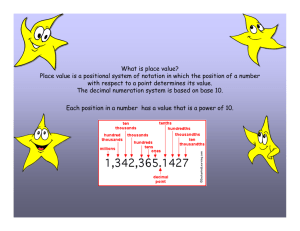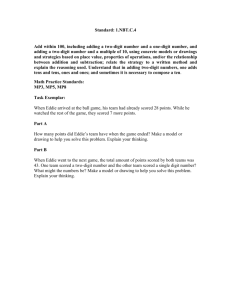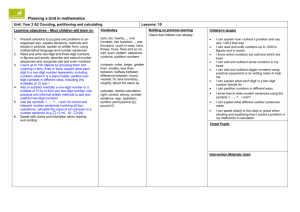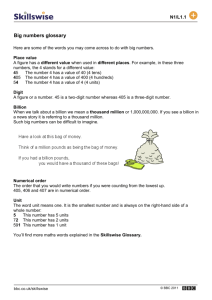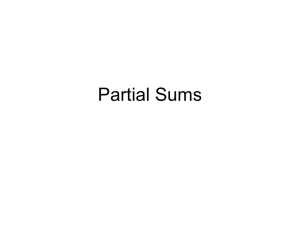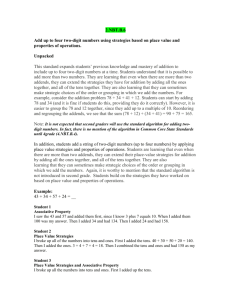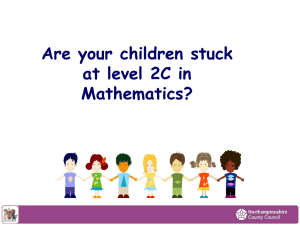Place Value of Two-Digit Numbers Laura Hickey Spring 2011 Grade
advertisement
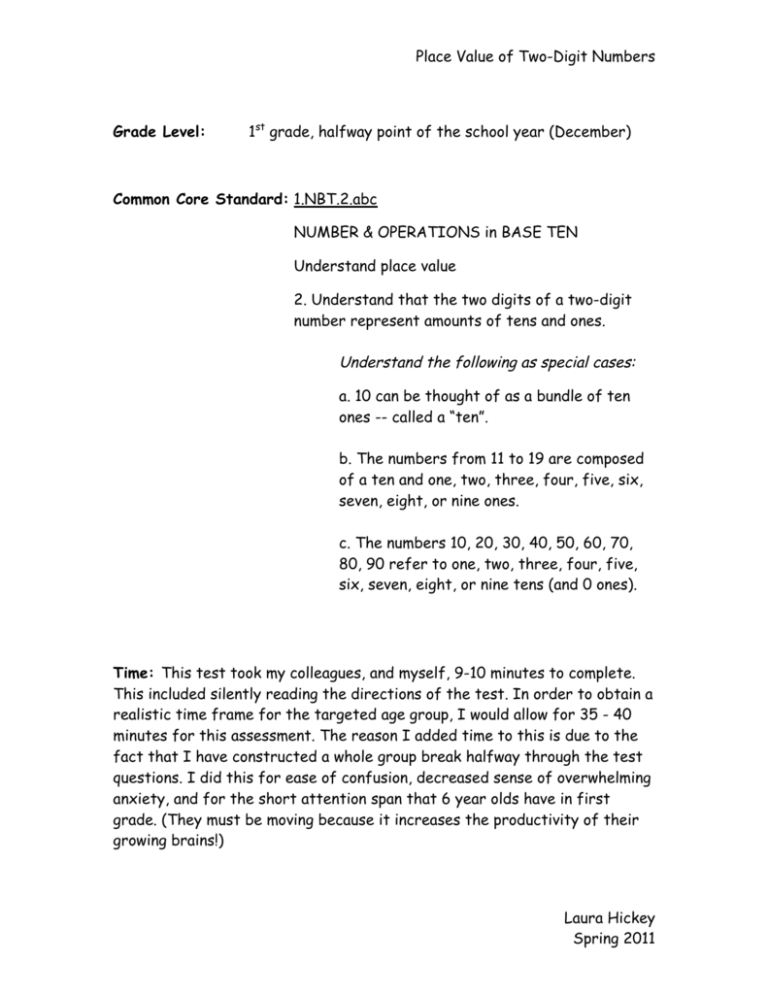
Place Value of Two-Digit Numbers Grade Level: 1st grade, halfway point of the school year (December) Common Core Standard: 1.NBT.2.abc NUMBER & OPERATIONS in BASE TEN Understand place value 2. Understand that the two digits of a two-digit number represent amounts of tens and ones. Understand the following as special cases: a. 10 can be thought of as a bundle of ten ones -- called a “ten”. b. The numbers from 11 to 19 are composed of a ten and one, two, three, four, five, six, seven, eight, or nine ones. c. The numbers 10, 20, 30, 40, 50, 60, 70, 80, 90 refer to one, two, three, four, five, six, seven, eight, or nine tens (and 0 ones). Time: This test took my colleagues, and myself, 9-10 minutes to complete. This included silently reading the directions of the test. In order to obtain a realistic time frame for the targeted age group, I would allow for 35 - 40 minutes for this assessment. The reason I added time to this is due to the fact that I have constructed a whole group break halfway through the test questions. I did this for ease of confusion, decreased sense of overwhelming anxiety, and for the short attention span that 6 year olds have in first grade. (They must be moving because it increases the productivity of their growing brains!) Laura Hickey Spring 2011 Place Value of Two-Digit Numbers Readability Statistics: This test was evaluated using the Flesch-Kincaid leveling system. I calculated this test twice; the first calculation equates to a grade level of 2.6 (the month of Jan-Feb of 2nd grade), while the second calculation equates to a grade level of 1.6. These grade level calculations determine the estimated reading level of the students. The first calculation includes the entirety of the test, while the second calculation only depicts the student directions. The reason for the varied estimations is due to the fact that first graders have emerging reading skills and although it is growing by the day, it is unrealistic to assume that the students will be able to correctly read the directions of the test. Therefore, this test will be read out loud as the class follows along. There will also be more verbal directions stated at that time to minimize any confusion and give more aide where it is needed. Laura Hickey Spring 2011 Place Value of Two-Digit Numbers Literature Connections: Place Value by Danielle Carroll On The Ball: Learning to Identify the Place Value of Ones and Tens by Autumn Leigh More or Less by Stuart Murphy More or Less: A Rain Forest Counting Book by Rebecca Davis Lesson Ideas: Daily Numbers is a daily attention-grabber that would enforce number sense of a realistic nature would be to incorporate the calendar days and the school days. By having the students count the number of days they have been in school gives them an opportunity to visualize groups of ten. This can be done by placing single straws in the ones pocket and when there are ten straws there, they can be tied together with a rubber band (creating a “bunch” or a “ten”) and placing it in the tens column. This is repeated on a daily basis and the learning stretches until the very last day of school, as students have learned to count past 100! Laura Hickey Spring 2011 Place Value of Two-Digit Numbers Keynote Interactive is a useful software program that incorporates instant gratification of any educational concept. It is designed like a powerpoint slideshow with the exception of adding the student’s voice and video. To see an example of this program being used to enhance the understanding of place value, visit http://etechplace.org/clough/?s=place+value Number Toss is a math game that incorporates two simple objects; a pair of dice and a place value mat. The object of the game is to create as many two-digit numbers as possible. This is best if played in groups of two. A student will roll the dice and write that number shown in two different ways. This can be written numerically, pictorially, or in written form. Let’s look at an example…student A rolls a 3 and a 7. Student A could place the 3 in the tens column and the 7 in the ones column, forming the number 37. The other option is to make the number 73, with the 7 in the tens column and the 3 in the ones column. This lesson would reiterate the understanding that the 7 (when placed in the tens column) is actually representing 7 tens or 70, not just 7. Build a Number is another math game that could be used at any given time of the school day or used as a small group activity during math centers. This will continually keep students thinking about place value of tens and ones as they “see” the number line in their heads. The teacher would say, “Build a number between 60 and 70.” The students would be able to use their place value mats and their specified counters to build any number that would “fit” into the range. 100 Chart Challenge Using a 100 chart, this hands-on activity could be implemented using whole group instruction. The teacher, or other students, would pose questions to the class. For example, “What is 10 more than 50?” Children & a Number Line gets students moving! It is simple, yet very effective. Each student receives a numbered card (1-99) and they must work together to place themselves in number order, or by group. Teachers, have fun with this! (“All of you who have a six in the ones column….If you are a one-digit number….If you are more than 55…) Laura Hickey Spring 2011 Place Value of Two-Digit Numbers Summary and Explanation: This test was designed with the concept of the ten frames. This is the strategy that is explicitly taught from the math curriculum at the school I teach. Although other ways of identifying numbers are welcomed and encouraged, I have written this test so that it is familiar to those students who have been taught place value with the aide of ten frames. The estimation of total point value has been exempt from this test given the circumstance that this test is constructed around numbers and base ten values. The level of understanding that is needed for this test does not meet that of the understanding of estimation practices. In order for first graders (at this time of the year) to be able to properly estimate a given value, it would require a strong sense of addition, or large grouping of numbers. Even if an estimation jar was incorporated in the classroom on a weekly basis, I am not sure that the students would be able to realistic approach that concept on a math test of their performance. To resolve this issue, and keep the students involved in their overall performance, I have chosen to use a pictorial form of evaluation. This is evident on the last page of the test as I ask students to reflect upon their performance on the test. Underneath the possible “answers” are number ranges that correspond to the possible scores. I feel that the self-reflection piece is appropriately placed at the end of the test because this will ease the flow and decrease the anxiety among students. The point value for each individual question has been placed at the top of every page where a new section of questions is introduced. The reason I chose to place the point values this way is due to the fact that the test is surrounding the understanding of numbers and number recognition. I felt that the added repetition of numbers might distract the students by having too many characters on the pages and causing confusion. Laura Hickey Spring 2011 Place Value of Two-Digit Numbers The brain break mentioned on the bottom of page two is meant as a literal break. I have adapted this test to best fit the needs of the students in my classroom. One of the many things we do during the school week is take “brain breaks” periodically. This is part of the behavior management plan that the entire school uses. It promotes a stable learning environment, while creating a welcoming place to learn and teach others. The brain break usually consists of a quick run, or walk, around a line of trees right outside our classroom door (each classroom has a door that leads directly to the outside). Given the fact that this test would be used during the winter months, it may be advisable to change that motivator on the test. All in all, the rock garden was intended to be a literal break for the students to let their brains relax for a moment and relieve any tension that may have built up during the test. The last question (#11) was created with the intention of giving the students a choice. By this I mean, I would allow the students to use a manipulative of their choice for counting purposes (a concrete representation) but it will not be required. I chose to do this specifically for the purpose of allowing creativity and diversity among solving strategies. There may be more than one way to correctly solve this math story and by giving students counting objects, it may inhibit the solutions and restrict their thinking processes. My overall reasoning stems from the background experience that I have gained from working in a first grade classroom for two consecutive years. I have been awarded the opportunity to physically see the motivated bodies of six year-olds when it comes to math lessons. They are motivated to learn new things, while consequently teaching others new strategies and concepts as well. Not only can we teach our students, but our students can teach us. Laura Hickey Spring 2011 Place Value of Two-Digit Numbers Mathematician (that’s you!) _______________________ Date_________ Points earned ____/29 Exploring Place Value This exploration will show me how well you understand the place value of two-digit numbers. For questions #1-5, you will use a green, orange, blue, red, and yellow crayon. You will also use a 100 chart. We will begin when your 100 chart is sitting beside this page. Here’s your job…. (1 point each) 1. USE your green crayon. CIRCLE the number that is eight ones. 2. USE your orange crayon. CIRCLE the number that is two tens and zero ones. 3. USE your blue crayon. CIRCLE the number that is four tens and three ones. 4. USE your red crayon. CIRCLE the number that is seven tens and six ones. 5. USE your yellow crayon. CIRCLE the number that is one ten and two ones. Way to go! You are on a roll. Keep up the good work, Mathematician! Laura Hickey Spring 2011 /5 Place Value of Two-Digit Numbers For questions #6-8, you will use base ten blocks. First, BUILD the number using your place value mat. Next, WRITE the amount of tens and ones you have. Lastly, FINISH the sentence. Here’s your job…. 6. (3 points each) I have _____tens and ______ ones. My number is __________ . 7. I have _____tens and ______ ones. My number is __________ . 8. I have _____tens and ______ ones. My number is _________ . You have put your brain to the test! You deserve a brain break Let’s take a walk around our rock garden! Laura Hickey Spring 2011 /9 Place Value of Two-Digit Numbers For questions #9-10, you will use base ten blocks. First, BUILD the number on your place value mat. Then, DRAW the number on the chart. Lastly, WRITE that number in the space provided. Here’s your job…. 9. (3 points each) BUILD and DRAW the number that is three tens and four ones. Tens Ones I drew the number ______ . 10. BUILD and DRAW the number that is five tens and three ones. Tens Ones I drew the number ______ . Laura Hickey Spring 2011 /6 Place Value of Two-Digit Numbers For question #11, you will use the picture to help you solve the math story. (9 points) Mrs. Sprinkle sells cookies by the box. One box holds 10 cookies. Mrs. Sprinkle has baked 16 cookies. How many boxes can she sell? How many cookies will she have leftover? Here’s your job…. DRAW a rectangle around each box of cookies that Mrs. Sprinkle can sell DRAW an X on the cookies that will be leftover Mrs. Sprinkle can sell ________ boxes of ten cookies. She will have ________ cookies leftover. You have almost finished! Stretch out your fingers. Take a deep breath. Turn the page… /9 Laura Hickey Spring 2011 Place Value of Two-Digit Numbers Here’s your LAST job…. Please tell me about your feelings. Be honest (Remember, we only cheat ourselves from learning when we do not tell the truth.) Circle the picture that best describes YOU. How do you think you did on the test? I think I did… Good 29 – 26 O.K. 25 – 22 Not so Good 21 - 0 Would you like to have another test like this? Yes Maybe No Yeah, student’s name, you did it! Give yourself a silent pat on the back! Laura Hickey Spring 2011 Place Value of Two-Digit Numbers 100 Chart Laura Hickey Spring 2011

